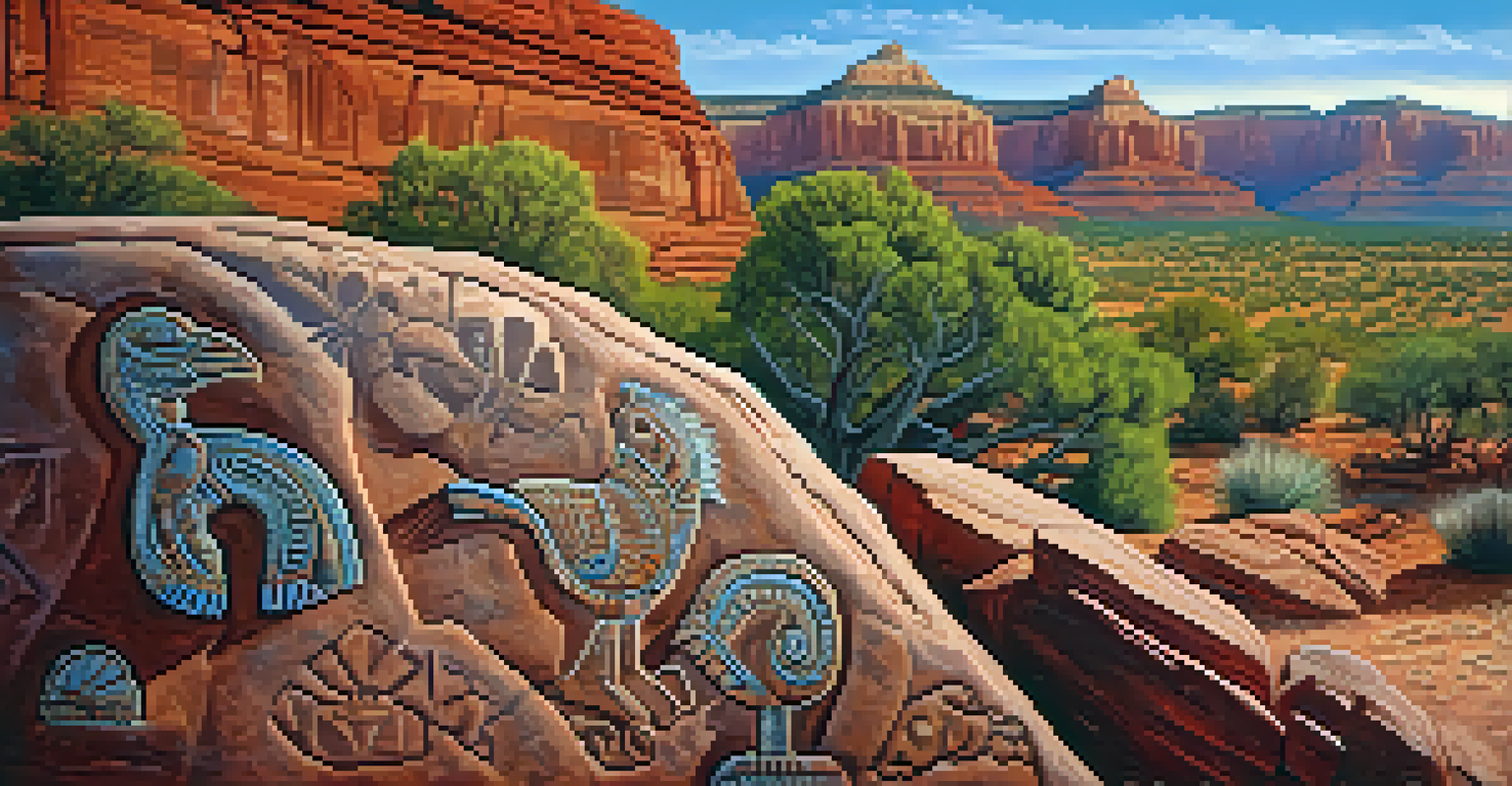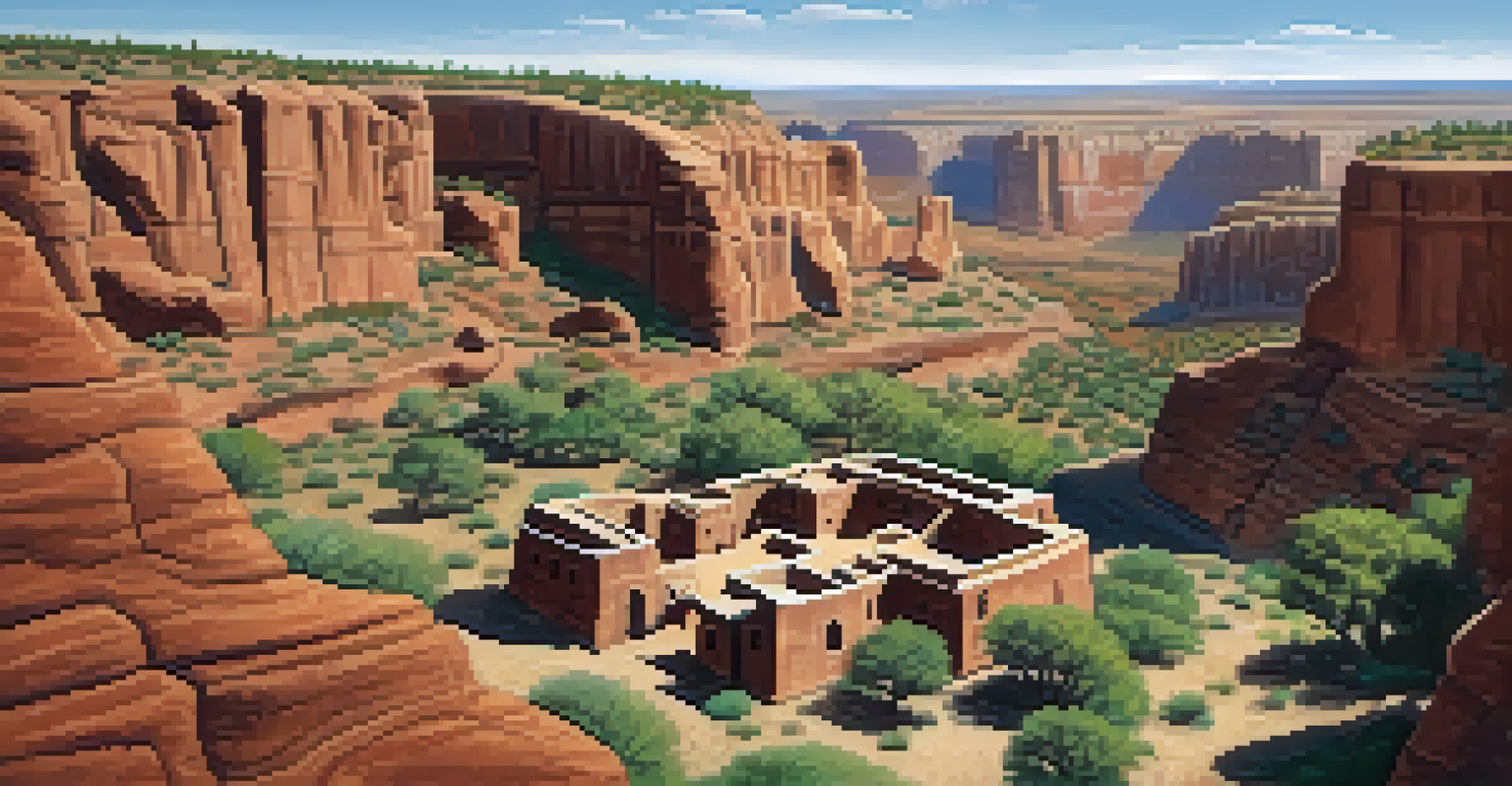Sedona's Ancient Puebloan Ruins: A Glimpse into the Past

Understanding the Ancient Puebloans of Sedona
The Ancient Puebloans, often referred to as the Ancestral Puebloans, were a remarkable civilization that thrived in the American Southwest. In Sedona, Arizona, their presence is marked by fascinating ruins that tell stories of resilience and adaptation. These early inhabitants were skilled farmers, artisans, and builders, utilizing local resources to create their homes and communities.
The land is the foundation of our culture, our spirituality, and our identity.
What sets the Ancient Puebloans apart is their deep connection to the land. They developed intricate agricultural systems, growing crops like corn, beans, and squash in a challenging climate. This reliance on agriculture shaped their social structures and daily lives, demonstrating their ingenuity in overcoming environmental hurdles.
Sedona's stunning red rocks served not just as a backdrop but also as a canvas for their cultural expression. The ruins left behind reflect a sophisticated understanding of architecture and community planning, revealing much about their way of life and values.
The Architectural Marvels of Sedona's Ruins
When you explore the ruins in Sedona, you'll encounter structures that showcase the architectural prowess of the Ancient Puebloans. They built impressive stone dwellings, often nestled into cliffs and canyons, which provided natural protection and insulation. These structures, typically made of sandstone and adobe, have withstood the test of time, offering a glimpse into their engineering skills.

One of the most notable sites is the Palatki Heritage Site, where you can see ancient cliff dwellings and rock art. Walking through these ruins, you can almost hear the echoes of the past, imagining families gathering in these spaces for warmth and community. The careful placement of these buildings shows a deep understanding of the surrounding environment.
Ancient Puebloans Thrived in Sedona
The Ancient Puebloans adapted to Sedona's challenging environment through skilled agriculture and community building.
The ruins also highlight the Puebloans' connection to the celestial world. Many structures were aligned with solar and lunar events, indicating their knowledge of astronomy and its importance in their cultural practices. This integration of architecture with nature speaks volumes about their worldview.
Rock Art: A Window into Puebloan Beliefs
Sedona's landscape is adorned with petroglyphs and pictographs, providing insight into the spiritual and daily life of the Ancient Puebloans. These rock art creations serve as a form of communication, telling stories of their beliefs, rituals, and experiences. Each symbol carved or painted onto the stone carries meaning, often linked to their connection with nature and the cosmos.
Preservation of our past is essential to understanding our present and shaping our future.
For instance, you might find depictions of animals, which were significant in their mythology, or symbols representing agricultural cycles. Each piece of art invites you to ponder the thoughts and emotions of those who came before us. It’s like opening a dialogue across centuries, where the past and present intersect.
Visiting these rock art sites can be a powerful experience; it’s as if the whispers of the ancients are carried on the wind. This connection to their beliefs and practices enriches our understanding of what it meant to be a Puebloan in Sedona, blending art with history.
The Role of Water in Puebloan Life
Water was crucial for the survival of the Ancient Puebloans, especially in the arid landscapes of Sedona. They developed sophisticated methods to manage this precious resource, including channeling rainwater and creating irrigation systems for their crops. The presence of water sources dictated where they settled and how they thrived.
Archaeological findings reveal that they built their communities near springs and streams, enabling them to sustain their agricultural practices. This strategic placement showcases their understanding of hydrology and the importance of water management. Without these innovations, their civilization might not have flourished as it did.
Architectural Wonders Reflect Culture
Sedona's ruins showcase the Puebloans' architectural genius, with structures that harmoniously integrated with their natural surroundings.
Exploring the ruins, you can appreciate how water shaped their environment and lifestyle. It was not just a resource but a lifeline that connected the Puebloans to the land, reinforcing their reverence for nature.
Sedona's Ruins and Modern Conservation Efforts
Today, Sedona's Ancient Puebloan ruins are protected sites, reflecting a commitment to preserving this rich history. Various organizations and local tribes work together to educate the public about the significance of these ruins and the need for their preservation. This collaboration is essential in ensuring that future generations can connect with this remarkable heritage.
Visitors are encouraged to respect these sites, which means following guidelines that protect the ruins from damage. Simple actions, like staying on marked trails and not touching the ancient structures, can make a big difference in preserving their integrity. Every step you take in these sacred spaces contributes to the ongoing story of the Puebloans.
Conservation efforts also involve research and archaeological work that deepen our understanding of Puebloan life. By studying these ruins, we gain insights into their culture, technology, and how they adapted to their changing environment over time.
Cultural Significance of the Puebloan Ruins Today
The Ancient Puebloan ruins in Sedona hold profound cultural significance, not just for archaeologists and historians but also for contemporary Native American tribes. Many tribes today trace their ancestry back to the Puebloans, and these sites are a source of pride and identity. They embody a deep connection to history, spirituality, and the land that continues to resonate.
Visiting these ruins is not just a tourist experience; it's an opportunity to honor and acknowledge the rich cultural heritage of the ancestors. Engaging with this history fosters a greater appreciation for the diverse narratives that shape our understanding of America’s past. It reminds us that the story of Sedona is intertwined with the lives of its original inhabitants.
Cultural Heritage and Modern Conservation
Today, the preservation of Puebloan ruins is vital for honoring their cultural significance and ensuring future generations connect with this history.
Moreover, modern Indigenous practices often incorporate teachings from their ancestors, linking past and present. This ongoing relationship with the land and its history enriches the cultural landscape of Sedona, encouraging visitors to reflect on their role in this narrative.
Planning Your Visit to Sedona's Ancient Ruins
If you're inspired to explore Sedona's ancient Puebloan ruins, planning your visit is key to making the most of your experience. Start by researching the various sites, such as Montezuma Castle National Monument and the aforementioned Palatki Heritage Site, to understand their historical context and accessibility. Each location offers unique insights into the Puebloan way of life.
Consider timing your visit during the cooler months, as Sedona can get quite warm in the summer. Early mornings or late afternoons are also ideal for exploring, allowing you to enjoy the stunning views of the red rock formations bathed in golden light. Don't forget your camera; the picturesque landscapes are worth capturing.

Lastly, take the opportunity to join guided tours or educational programs offered at these sites. Knowledgeable guides can provide deeper insights and stories that enrich your visit, helping you connect with the ancient Puebloans in a meaningful way. Your journey into Sedona's past will undoubtedly leave you with lasting memories.